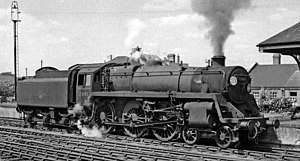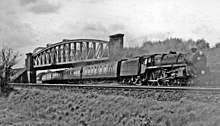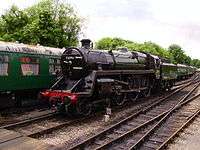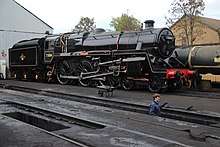BR Standard Class 5
The British Railways Standard Class 5MT 4-6-0 was one of the 12 standard classes of steam locomotive built by British Railways in the 1950s. It was essentially a development of the LMS Stanier Class 5 4-6-0 ("Black Five"). A total of 172 were built between 1951 and 1957.
| BR Standard Class 5 | |||||||||||||||||||||||||||||||||||||||||||||||||||||||
|---|---|---|---|---|---|---|---|---|---|---|---|---|---|---|---|---|---|---|---|---|---|---|---|---|---|---|---|---|---|---|---|---|---|---|---|---|---|---|---|---|---|---|---|---|---|---|---|---|---|---|---|---|---|---|---|
 73043 at Salisbury in 1963 | |||||||||||||||||||||||||||||||||||||||||||||||||||||||
| |||||||||||||||||||||||||||||||||||||||||||||||||||||||
| |||||||||||||||||||||||||||||||||||||||||||||||||||||||
| |||||||||||||||||||||||||||||||||||||||||||||||||||||||
| |||||||||||||||||||||||||||||||||||||||||||||||||||||||
Background
William Stanier's Black Five had been the most successful mixed-traffic type in Great Britain. Construction of the Black Fives had started in 1934 and continued past nationalisation to 1951. A new set of 'standard' locomotives was to be built by British Railways, based on LMS designs and incorporating modern ideas.
In particular, the Standard design incorporated features designed to make disposal of the engine after a working "turn" easier: a self-cleaning smokebox and a rocking grate removed the necessity for crews to undertake dirty and strenuous duties at the end of a long shift.[1] This was a necessary investment with the ever-increasing costs of labour following the Second World War.
The original design proposal for the class 5 locomotive had a 4-6-2 wheel arrangement, similar in concept to the Bulleid Light Pacifics that performed impressively during the 1948 Locomotive Exchanges. However this was deemed unnecessarily large and costly for a class 5 power requirement, so the successful LMS Class 5 4-6-0 design was used as the basis instead. The pacific design went on to be enlarged and used for the BR Standard Class 6.
Design and construction

The design work was done at the ex-LNER Doncaster Works but the bulk of the construction was done at Derby Works. The locomotive featured a BR standard boiler very similar in dimensions to the Stanier Type 3B fitted to the Black Fives, but made from manganese steel instead of nickel steel. The most obvious visible changes were a higher running plate, slightly enlarged driving wheels (from 6 ft 0 in (1.829 m) to 6 ft 2 in (1.880 m)), increased cylinder bore (from 18½ in (457 mm) to 19 in(483 mm)), a standard cab with external pipework and the regulator gland on the driver's side of the boiler below the dome. Many of these changes were to reduce maintenance or to incorporate standard components that could be shared between other standard classes.
The first of the class, 73000, was outshopped from Derby in April 1951 and 30 were in service by January 1952. There was then a gap in construction before Derby resumed building its remaining 100 engines. 42 were built at Doncaster, starting in August 1955 and finishing in May 1957, with Derby's last engine following a month later.
Thirty engines, numbers 73125 to 73154, were built with Caprotti valve gear and poppet valves.
| Number | Date | Builder | Tender | Valve gear | Notes |
|---|---|---|---|---|---|
| 73000–29 | 1951 | Derby | BR1 | Walschaerts | 25 for LMR, 5 for ScR |
| 73030–49 | 1953 | Derby | BR1 | Walschaerts | 10 for LMR, 10 for ScR |
| 73050–52 | 1954 | Derby | BR1G | Walschaerts | for SR (S&DJR) |
| 73053–64 | 1954 | Derby | BR1H | Walschaerts | 10 for LMR, 2 for ScR |
| 73065–71 | 1954 | Derby | BR1C | Walschaerts | for LMR |
| 73072–79 | 1955 | Derby | BR1C | Walschaerts | 3 for LMR, 5 for ScR |
| 73080–89 | 1955 | Derby | BR1B | Walschaerts | for SR |
| 73090–99 | 1955 | Derby | BR1C | Walschaerts | for LMR |
| 73100–09 | 1955 | Doncaster | BR1B | Walschaerts | for ScR |
| 73110–19 | 1955 | Doncaster | BR1F | Walschaerts | for SR |
| 73120–-24 | 1956 | Doncaster | BR1B | Walschaerts | for ScR |
| 73125–34 | 1956 | Derby | BR1B | Caprotti | Poppet valves; for WR |
| 75135–44 | 1956 | Derby | BR1C | Caprotti | Poppet valves; for LMR |
| 73145–54 | 1957 | Derby | BR1B | Caprotti | Poppet valves; for ScR |
| 73155–59 | 1956 | Doncaster | BR1B | Walschaerts | for ER |
| 73159-171 | 1957 | Doncaster | BR1B | Walschaerts | for NER |
In service
These locomotives had a trouble-free introduction in comparison to several of the other Standard classes and were used interchangeably with the pre-nationalisation class 5 engines they supplemented. They were utilised as the haulage power on duties varying from fast passenger trains to slow unfitted freight trains, displaying their versatility.
Different regional allocations had differing tender designs, with locomotives assigned to the Southern Region having tenders with high water capacity to make up for the lack of water troughs.
The Standard 5 was a much more economical high speed express engine than the Black 5. Like the "Clan" class locomotives, Standard 5s, with their high-stepped running board, were partly conceived to be more economical and serviceable replacements for the Bulleid Pacific, and the Standard Class 5 were fast, they could really fly with good steam, easily to just under 100mph in the view of many engine drivers. Like the Clans, which could only manage one more carriage on an express than a 'Five' the Standard Fives took a long time to shake down, and only started to really pull when different firing techniques, which allowed them to steam using poor quality coal were developed.[2] They pulled much of the traffic on the last express lines for steam in the mid and late 1960s: Edinburgh-Aberdeen, London- Southampton-Bournemouth- Weymouth and local express traffic in the North and Midlands around Sheffield and Leeds. They were also used on the locals between Liverpool, Manchester and Blackpool, some steam hauled to the last day of steam in 1968.
Naming

In 1959, 20 of the Southern Region locomotives were named, the names being transferred from SR King Arthur class locos that were then being withdrawn. These were:
- 73080 Merlin
- 73081 Excalibur
- 73082 Camelot
- 73083 Pendragon
- 73084 Tintagel
- 73085 Melisande
- 73086 The Green Knight
- 73087 Linette
- 73088 Joyous Gard
- 73089 Maid of Astolat
- 73110 The Red Knight
- 73111 King Uther
- 73112 Morgan Le Fay
- 73113 Lyonnesse
- 73114 Etarre
- 73115 King Pellinore
- 73116 Iseult
- 73117 Vivien
- 73118 King Leodegrance
- 73119 Elaine
Withdrawal
| Year | Quantity in service at start of year | Quantity withdrawn | Locomotive numbers | Notes |
|---|---|---|---|---|
| 1964 | 172 | 15 | 73012/17/24/27/46–47/52/58/61/74/76, 73109/16/61/64. | |
| 1965 | 157 | 43 | 73001/03/08/15/21/23/30–32/36/38/41–42/44/49/51/54/56/62–63/68/75/77/84/90–91, 73103–04/06/11–12/22–24/47–48/52/62–63/65–68. | |
| 1966 | 114 | 38 | 73005/07/09/13/16/28/55/57/72/78/80–83/86–89/95/98–99, 73101–02/05/07–08/14/20–21/45/49–51/53–54/69–71. | |
| 1967 | 76 | 53 | 73002/04/06/11/14/18–20/22/25–26/29/37/39/43/45/48/59–60/64–66/70–71/73/79/85/92–94/96–97, 73100/10/13/15/17–19/27/29–30/37/39–41/44/46/55–56/58–60. | |
| 1968 | 23 | 23 | 73000/10/33–35/40/50/53/67/69, 73125–26/28/31–36/38/42–43/57. | |
Accidents and incidents
- On 25 August 1958, locomotive No. 73042 was hauling a sleeper car train which overran a signal and was in a head-on collision with a train formed from two electric multiple units at Eastbourne, East Sussex. Five people were killed and 40 were injured.
- In 1958, locomotive No. 73111 was hauling a passenger train that derailed at Millbrook, Hampshire due to a faulty point motor moving a set of points under the train.[3]
Variations & proposed changes
The main variation across the class was the valve gear, with 142 using Walschaerts valve gear and the remaining 30 using British Caprotti valve gear. There was little difference in performance between the two groups, but the Caprotti fitted engines had a reputation for being good performers at higher speeds. There was potential for more BR standard locomotives to have Caprotti valve gear fitted as it allowed for longer periods between inspections, offsetting the higher initial cost of this valve gear.
Doncaster had designed double chimneys for the class, similar to the ones used on several of the BR Standard Class 4 4-6-0. If applied, this would have improved the draughting and increased the efficiency of the locomotives. With the Modernisation Plan of 1955 and the good performance of the class from the outset, these plans were shelved permanently.
Another proposal was to produce freight locomotives based from this design in response to criticism by the Western Region on the BR Standard Class 9F. The management believed that the 9Fs were too large and powerful for most heavy freight traffic, along with being more far more expensive to build and operate than the older 2-8-0 locomotives they supplemented. In response to this, the British Transport Commission drew a 2-8-0 Class 8F based on the Standard Class 5, in a manner similar to the LMS class 5 and 8Fs. Changes included a higher boiler pressure of 250 psi and driving wheels 5 ft 0 in (1.524m) in diameter to increase tractive effort. Preparations were made for series production to begin, but the work ceased after the Modernisation Plan was published.
Preservation
Five members of the class have survived into preservation and all have been steamed in preservation. 73050 was purchased directly from British Railways service for preservation but the other four engines were all rescued from Woodham Brothers scrapyard at Barry Island. To date 73096 has been the only member of the class to operate on the main line hauling railtours but in 2018 no. 73082 was moved by rail from its home at the Bluebell Railway to the West Somerset Railway.[4]
| Number & Name | Tender Attached | Builder | Built | Withdrawn | Service life | Location | Livery | Status | Image |
|---|---|---|---|---|---|---|---|---|---|
| 73050 "City of Peterborough" | BR1G | Derby Works | April 1954 | June 1968 | 14 Years, 2 months | Nene Valley Railway | BR Lined Black, Early Emblem | Boiler ticket expired in 2015, Under Overhaul | |
| 73082 "Camelot" | BR1B | Derby Works | July 1955 | June 1966 | 10 years, 11 months | Bluebell Railway | BR Lined Black, Early Emblem | Operational, Boiler ticket expires in 2025. |  |
| 73096 | BR1G | Derby Works | Nov 1955 | Nov 1967 | 12 years | Mid Hants Railway | BR Green, late Emblem | Purchased by and transferred to the Watercress Line, at which it was formerly a resident under private ownership, in November 2017. |  |
| 73129 | BR1B | Derby Works | Aug 1956 | Dec 1967 | 11 years, 4 months | Midland Railway - Butterley | BR Lined Black, Early Emblem | Static Display, Boiler ticket expired in 2016. One of only two engines left in Britain with Caprotti valve gear. | |
| 73156 | BR1B | Doncaster Works | Dec 1956 | Nov 1967 | 10 Years, 11 months | Great Central Railway | BR Lined Black, Early Emblem | Recently emerged from scrapyard condition and came into full traffic in May 2018. |  |
Notes
- Terry Essery, Steam Locomotives compared, Atlantic Transport Publishers, ISBN 0-906899-65-6
- Clive Groom(Engineman).DVD ' The story of the Standard, Southern and Western engines. Go Entertainment (2011)
- Bishop, Bill (1984). Off the Rails. Southampton: Kingfisher. pp. 76–77. ISBN 0 946184 06 2.
- https://www.railadvent.co.uk/2018/09/steam-locomotive-73082-camelot-to-make-rare-movement-on-mainline-tomorrow.html 73082 makes rare mainline move
References
- A Detailed History of BR Standard Steam Locomotives, - Vol 2 - The 4-6-0 and 2-6-0 Classes. RCTS ISBN 0-901115-93-2
- Bradley, Rodger P. (1984). The Standard Steam Locomotives of British Railways. David & Charles. ISBN 0715383841.
- Atkins, C.P. (1988) The BR Standard 2-8-0s. Rly Wld, 49, 222-3.
- Cliffe, Joseph. (2012) It began with 'Turbomotive'. Backtrack, 26, 637.
External links
| Wikimedia Commons has media related to BR Standard Class 5MT. |